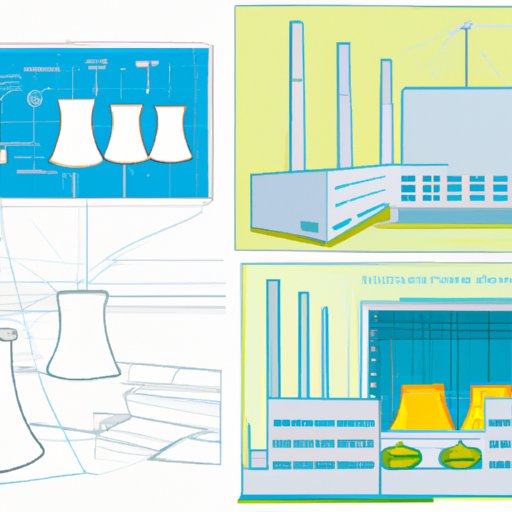Introduction
Nuclear power plants are large facilities that generate electricity through the process of nuclear fission. This process involves splitting atoms of certain elements to release energy, which is then used to heat water and produce steam. The steam drives a turbine and generator, which produces electricity. In this article, we will explore how these power plants work and discuss their components, processes, safety protocols, and potential benefits.
Overview of Nuclear Power Plant Components and Processes
At the heart of a nuclear power plant is a nuclear reactor, which consists of several key components. First, there is the nuclear fuel, which typically consists of uranium or plutonium. Second, there is the reactor coolant system, which is responsible for controlling the temperature and pressure within the reactor. Finally, there is the control system, which helps regulate the power output of the reactor.
Explaining the Nuclear Fission Process
Nuclear fission is the process by which atoms of certain elements are split, releasing energy in the form of heat. The heat is used to boil water, which produces steam. The steam is then used to drive a turbine and generator, producing electricity. The process starts when a neutron strikes the nucleus of an atom, causing it to split into two smaller atoms and releasing neutrons in the process. These neutrons then strike other atoms, repeating the process and creating a chain reaction.

Understanding the Role of Reactor Coolant Systems
Reactor coolant systems are responsible for controlling the temperature and pressure within the reactor. They do this by circulating a coolant, such as water or liquid sodium, through the reactor core. The coolant absorbs the heat generated by the nuclear fission process and carries it away from the reactor core, where it can be safely released. The coolant also helps maintain the desired pressure within the reactor.
Examining Nuclear Fuel Sources and Types
Nuclear fuel typically consists of uranium or plutonium. Uranium is the most common type of nuclear fuel, and it can be found in many parts of the world. Plutonium is a man-made element that is produced from the reprocessing of spent nuclear fuel. Other types of nuclear fuels include thorium, which is naturally occurring, and breeder reactors, which use uranium-238 and create plutonium as a byproduct.

Investigating Safety Protocols in Nuclear Power Plants
Safety is of paramount importance in nuclear power plants, and there are several protocols in place to ensure the safety of workers and the public. Emergency shutdowns can be initiated manually or automatically if the reactor temperature or pressure exceeds certain thresholds. Containment buildings are designed to contain any radioactive material that may escape from the reactor core. Additionally, radiation monitoring systems are in place to detect any leaks or releases of radiation.

Analyzing Nuclear Waste Management Strategies
Managing the waste produced by nuclear power plants is a critical component of ensuring safety. The waste is typically stored onsite in secure containers until it can be transported to a disposal facility. Some countries also have the option of reprocessing the waste, separating out the usable materials from the radioactive waste and recycling them for future use.

Exploring the Potential Benefits of Nuclear Power Plants
Nuclear power plants offer many potential benefits. One of the main advantages is that they produce very low levels of carbon emissions, making them a much cleaner source of energy than traditional fossil fuel plants. Additionally, nuclear power plants are incredibly reliable, as they can operate continuously for years without interruption. Finally, they are cost-effective to operate, as the cost of fuel is relatively low compared to other forms of energy production.
Conclusion
In conclusion, nuclear power plants are complex facilities that generate electricity through the process of nuclear fission. This process involves splitting atoms of certain elements to release energy, which is then used to heat water and produce steam. The steam drives a turbine and generator, producing electricity. Nuclear power plants are equipped with various components, such as reactors, coolant systems, and fuel sources, and have numerous safety protocols in place to protect workers and the public. Additionally, they offer many potential benefits, such as low carbon emissions, reliability, and cost-effectiveness.
(Note: Is this article not meeting your expectations? Do you have knowledge or insights to share? Unlock new opportunities and expand your reach by joining our authors team. Click Registration to join us and share your expertise with our readers.)
